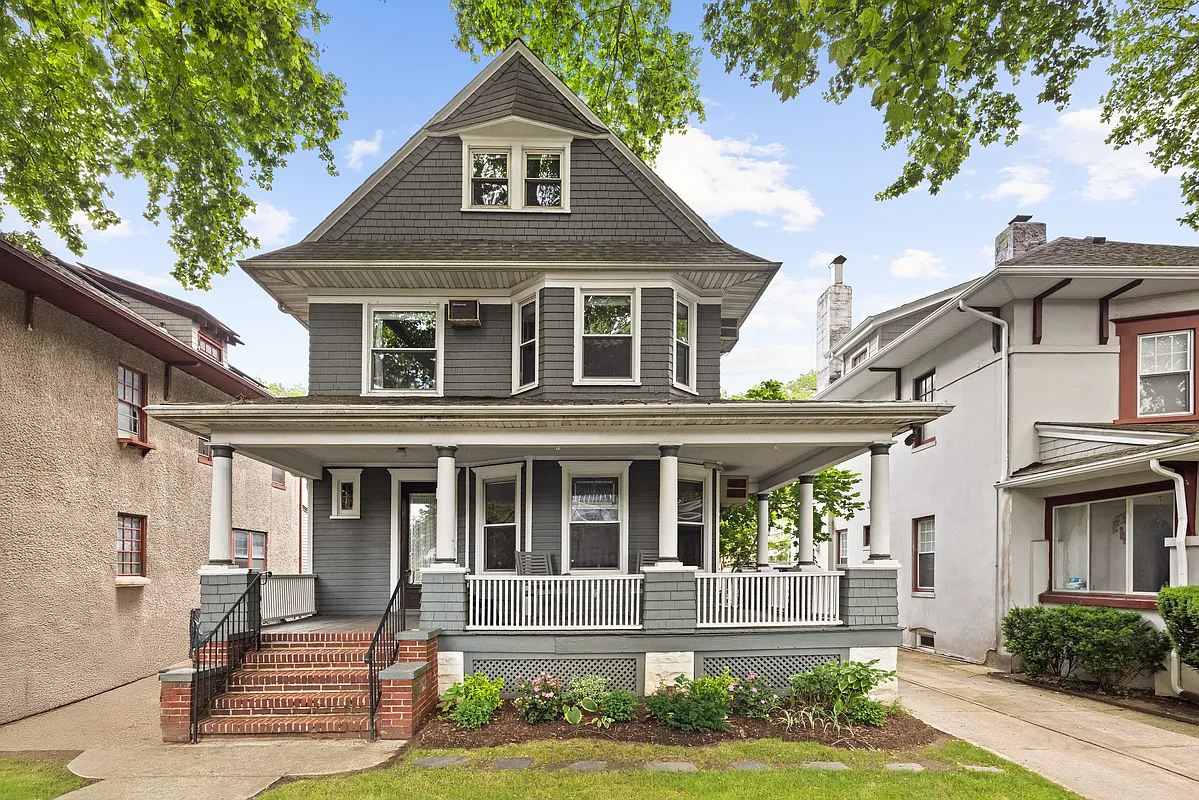House of the Day: 265 Sterling Street Revisited
When is someone going to step up at 265 Sterling Street? The Prospect Lefferts Gardens house isn’t huge and it’s not on the swankiest block in the nabe, but it sure is cute. The price has come down from $735,000 to $649,000 since we last took a look in July, bringing it to within less…


When is someone going to step up at 265 Sterling Street? The Prospect Lefferts Gardens house isn’t huge and it’s not on the swankiest block in the nabe, but it sure is cute. The price has come down from $735,000 to $649,000 since we last took a look in July, bringing it to within less than $20,000 of what the widget estimate was. What’s it gonna take to move this place?
265 Sterling Street [Douglas Elliman] GMAP P*Shark
House of the Day: 265 Sterling Street [Brownstoner]





As far as I know there is no-one living in the English basement, although it may at one time have been rented out illegally as an apartmenr (a very common practice around here). In order to meet NYC code that a basement may not be used as living space, the stove will have to be removed, and the tub made to “disappear” (I know many people who’ve just built a wall in front of it) before the appraiser comes. You’re allowed to have a kitchenette (no stove) and a stall shower in a basement — call it a rec romm or home office and you’re fine. The broker should never have allowed that space down there to be labelled a bedroom on the floor plan.
Apart from that, this is a lovely block, with an active block association, and in the PLG historic district (though not the Manor). The 2/5 stop is on the corner at Nostrand Ave. It’s a one-way street, so not much traffic, and double-parking is tolerated during street cleaning (unlike on my street, which is two-way).
DIBS, you are right on that one, unless Bloomberg’s close aid totally f’s it up.
Question –
This house is zoned as a 2 family and when I look at the floorplan I see three kitchens – or 3 units. If you are BUYING a house that does not match the zoning for the house – do you have to rip out the 3rd kitchen immediately? Also, in that house I wonder if the basement kitchen is not up to code? I know there are rules concerning how far or above grade a room has to be in order to have a kitchen. Does the improper use impact one’s ability to get financing.
Perhaps this is why the house is sitting on the market.
I don’t know what much of what the previous few posts mean…. I know what all of the words mean separately, but not all mixed together.
While I think it’s sad that the world economy is run mostly by a bunch of semi-retarded frat boys, at least that means *they* have to have thoughts like that above and not me!!
(And DIBS – I’m not calling you a semi-retarded frat boy. You just happen to be part of an industry infested with them. Hopefully you at least get to trade handies at the urinals.)
If I’m right that C will be $8.00 in a year, nothing else matters.
Not necessarily true. you forgot to add solvency constraints that every bank is encountering these days due to the BIS II (and soon BIS III) standards. Pricing on the loans will definately increase and on top of that banks will be even more selective on who they lend to.
Originations will not be like they were in 2006 and certainly the securitizations of this asset class will be slow moving for years to come which means these mortgages will sit on the banks books for some time. Increasing the pricing on the loans is the only way to make up for this. So I agree on the pricing part not so much on aggressiveness on risk. One would think after this last debacle banks would be more risk adverse
According to Streeteasy, it was in contract for $650k back in January.
http://streeteasy.com/nyc/sale/384767-townhouse-265-sterling-street-crown-heights-brooklyn
Additionally, as short rates (very short) rise, the banks will become more aggressive in lending since they can’t borrow at near zero. They will have to get more aggressive and take on more risk to maintain the net interest margin and earnings.
sashae…this is one og the most telegraphed changes in the financial markets…if there was going to be a spike in rates because of it, it would have happened…
I think Blackrock knows more about this than people here….
Mortgage-Bond Market Prepared for Fed’s Exit Today (
March 31 (Bloomberg) — The end today of the Federal Reserve’s unprecedented buying of mortgage securities won’t have much effect on the market, BlackRock Inc.’s Curtis Arledge said.
Yields on agency mortgage securities relative to benchmark rates will likely widen “a bit†and become more volatile after the Fed’s exit, though probably won’t expand more than 0.2 percentage point, Arledge, chief investment officer of fixed income at New York-based BlackRock, said today in an interview with Bloomberg Television.
“It’s been one of the more telegraphed changes we’ve seen in a long time,†said Arledge, who oversees about $590 billion at the world’s largest money manager. “The marketplace has positioned itself for the Fed to be absent.â€
The Fed’s $1.25 trillion of purchases in the $5.4 trillion market of securities guaranteed by government-supported Fannie Mae and Freddie Mac or federal agency Ginnie Mae helped drive yield premiums to the lowest on record, which they remain near by some measures as the program ends.
The U.S. central bank began buying home-loan bonds in January 2009 to restrain financing costs amid the worst housing slump since the 1930s. Home prices in 20 metropolitan areas tumbled 33 percent from July 2006 through April 2009, then rose for five months before declining by a lesser amount over the next four, according to an S&P/Case-Shiller index.
‘Major Success’
“The program was a major success and kept home prices from really collapsing,†Scott Simon, head of mortgage-backed securities at Newport Beach, California-based Pacific Investment Management Co., manager of the world’s biggest bond fund, said today in an e-mail.
“They did make MBS become expensive (they probably didn’t need to buy the last $400 billion), but money managers and others are now underweighted and will repurchase if MBS underperform,†he said.
About 53 percent of more than 150 mortgage investors surveyed by JPMorgan Chase & Co. in the middle of this month held less of the debt than found in benchmark bond indexes.
“When I was in Asia a few months ago, visiting maybe 30 clients, they were saying, when is the Fed going to stop buying mortgage-backed securities, because we’d like to,†Brian Lancaster, the head of asset- and mortgage-backed securities strategy at Stamford, Connecticut-based RBS Securities Inc., said today in a Bloomberg Television interview.
Purchases End
The Fed today is also scheduled to stop buying the corporate debt of Fannie Mae, Freddie Mac and the Federal Home Loan Bank system, after $172 billion of purchases, according to data compiled by Bloomberg. The central bank ceased buying Treasuries in October, after acquiring $300 billion.
The difference between yields on Washington-based Fannie Mae current-coupon 30-year fixed-rate mortgage-backed securities and 10-year Treasuries rose 0.03 percentage point today to about
0.65 percentage point as of 11:45 a.m. in New York, according to Bloomberg data.
That spread reached 0.59 percentage point on March 10, the lowest since at least 1984. The gap averaged 1.32 percentage point from 2000 through 2009.
Spreads for the Fannie Mae securities on a so-called option-adjusted basis, which takes into account prepayment uncertainty, against interest-rate swaps have already widened, according to Bloomberg data. Option-adjusted spreads rose today to 0.11 percentage point, matching the highest since September, after climbing from negative 0.22 percentage point on Dec. 21.
Mortgage-Bond Returns
Agency mortgage securities returned 1.67 percent this quarter, the most since the third quarter, according to Bank of America Merrill Lynch’s Mortgage Master Index. Through yesterday, the debt returned 0.59 percentage point this month more than Treasuries that have maturities similar to the securities’ projected average lives, the most since October, according to Barclays Capital index data.
The average rate on a typical 30-year fixed-rate mortgage was 4.99 percent in the week ended March 25, according to McLean, Virginia-based Freddie Mac. That was up from a record low of 4.71 percent in the week ended Dec. 3, and down from a high last year of 5.59 percent in June.
Increases in Treasury yields this month have driven home- loan rates higher, as record auctions of government notes contributed to an increase in 10-year yields to 3.84 percent today, from 3.60 percent on March 4, Bloomberg data show.
The expected strength in the market for mortgage bonds with government-backed guarantees after the Fed’s exit differs with the still limited demand from banks and others for new housing debt with credit risk, Arledge and Lancaster said.
Mortgages or Corporates
While some investors believe the end of the Fed program will draw bond buyers to mortgage securities from corporate notes, hurting company-debt spreads, those premiums remain wide enough to continue to attract investors as the economy improves, Roger Bayston, a senior vice president in San Mateo, California- based Franklin Templeton Investment’s fixed-income group, said.
That means investors may not shift much until corporate spreads tighten further, Bayston, who helps oversee more than $200 billion of bonds, said in a March 17 telephone interview.
Spreads on investment-grade corporate bonds fell to 1.49 percentage points yesterday from a record 6.18 percentage points in 2008, after averaging 1.05 percentage points from 2003 through 2007 when the economy grew, Barclays Capital data show.
“The risk there is declining, and the return opportunities remain pretty solid,†Bayston said. “The deleveraging that continues to happen in corporate America has been good for corporate credit,†he added.